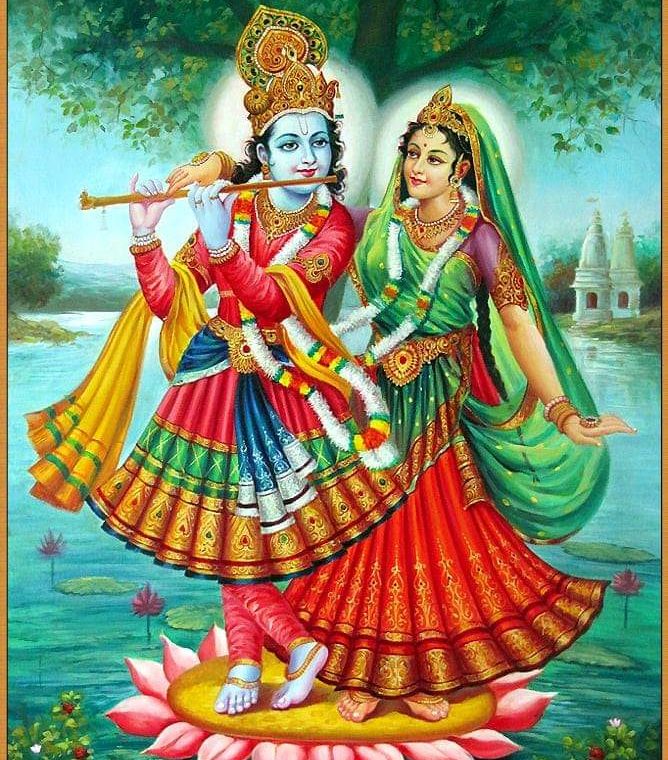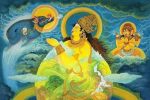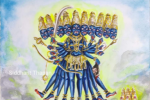NAME 72
Mādhavaḥ माधवः
Mā refers to Goddess Lakṣmī and dhava means husband. Goddess Lakṣmī is the consort of Viṣṇu. Both Viṣṇu and Śiva hold their consorts in high esteem. Viṣṇu holds Lakṣmī in His chest and Śiva holds His consort Śakti in His left lap. Both Viṣṇu and Śiva are the cause of creation and this cause is effected through their power of projections, known as their consorts. If one desires to reach the lotus feet of Viṣṇu, he has to first surrender to His projecting power Goddess Lakṣmī, who alone is capable of taking him to Him.
This also refers to Kṛṣṇa’s descendance, the Madhu or Yādava-s
Maadhavah – The Consort of Lakshmi
Maadhavah is one of the more popular names for Bhagavan Vishnu and occurs 3 times in the Vishnu Sahasranamam. It has a number of meanings as summarised below:
a) Mayah Dhavah Madhavah – One who is the Lord or consort of ‘Ma’ (Lakshmi). The notion here is that Bhagavan and Sri are eternally and constantly associated with each other, and are Inseparable. Her power is invincible and awe-inspiring and She is considered equal to Vishnu. She is the Supreme Being who lives in the hearts of all beings of the Universe and She is endowed with divine forms. In Sri Lakshmi Sahasranamam, She is called the Supreme Prakriti who possesses the six qualities (Shad Gunas)- Gnana, Bala, Aishvarya, Veerya, Shakti and Tejas. She is one with Him, and yet remains distinct like the moon-light of the cool-rayed moon. She is endowed with all glory and is eternal. Her Dharma is the same as that of Bhagavan.
b) One who is attained through the Madhu Vidya, by practicing Mauna, Dhyaana, and Yoga. The reference to this comes from the MahaBharata –
madhuvidyaavabodhatvaat dhavatvaadvaa shriyo’nisham |
maunaad-dhyaanaacca yogaacca viddhi bhaarata maadhavam ||
MB Udyoga parva 68.4
Meaning: Here, ‘Ma’ stands for Mauna, ‘dha’ stands for Dhyaana, and ‘va’ stands for Yoga. He is experienced by the seeker who has stilled his mind through mauna, dhyaana, and yoga practices. Or, it can be said that He is Madhava because He is endowed with mauna, dhyaana, and yoga – He silently observes the physical, mental, and intellectual activities of all beings, and is ever the non-interfering Observer.
c) He is The Lord of knowledge. In this interpretation, ‘Ma’ stands for knowledge, and ‘Dhava’ is Lord. The support for this interpretation is from Harivamsa –
maa vidyaa ca hareh proktaa tasyaa Isho yato bhavaan |
tasmaad maadhava naamaasi dhavah svaamIti shabditah||
(Harivamsa 3.88.49)
Meaning: “O Hari! You are the Lord Dhava of ‘Ma’ (knowledge); hence you are named Madhava, the Master of ‘Ma’”.
d) Madhukule jatatvat Madhavah – One who is born in the race of Madhu, a Yadava.
e) Madhavah yasya sa Madhavah – One for whom there is no other Lord. This interpretation is included as one of the explanations for this Nama by Thirukkallam Sri Nrsimha Raghavachariar in his Bhashyam on Bhagavad Gita.
f) One who is the Silent Observer – this was discussed under b) above.
The first 2 meanings are given by Sri Adi Sankara and the rest by the other commentators.
Name Mādhava has three meanings:
1. ‘Mā’ means ‘Laxmi’ (Lakshmi) and ‘dhava’ means ‘husband’. Being Husband of Lakshmi, Bhagavān is known as ‘Mādhava’ or
2.[as said in Br. Up.], he who is cognised through ‘Madhuvidyā’ is known as ‘Mādhava’. or
3. ‘Vyāsa in Mahā. udyoga. 70.4 says ‘O Bhārata! Know Mādhava by ‘Silence’(maun), Meditation (Dhyāna) and by ‘Yōga’
७२. ॐ माधवाय नमः |
72. OM Mādhavāya Namaḥ
Mādhavaḥ -The Lord of Maayaa, Spouse of Mahaalakshmee. Or, the term can signify the One who is ultimately experienced through a diligent practice of “Madhu technique”: the very famous Madhu Vidyaa of the Chandogya Upanishad. The term Maadhavah can also mean One who is the Silent (Mauni); who is ever the Non-interfering Observer, the Silent Witness of the physical, mental and intellectual activities in the realm of change. To put it in one word, He is the One whom the seeker experiences when he has stilled his mind which has been purified by Yoga practices.
Māyāḥ dhavaḥ (Śriyaḥ patiḥ) मायाः धवः (श्रियः पतिः) The dhava or husband of Mā or Śri who is otherwise known as Lakṣmi लक्ष्मि. Or as mentioned in Br̥hadāraṇyakopaniṣat, He is made known by the Madhu vidyā. Or in the Mahā Bhārata (Udyoga parva, Sanat sujāta parva 4) Vyāsa says ‘Maunā ddhyānācca yogācca viddhi bhārata mādhavamˈ, ‘मौना द्ध्यानाच्च योगाच्च विद्धि भारत! माधवम्’ O Bhārata! Know Mādhava by mauna (silence / contemplation), dhyāna (meditation) and Yoga (practice). He who is known by these is Mādhava. Mā signifies mauna, dhā signifies dhyāna and vā yoga.
INTERPRETATION GUIDED BY SANT VANI (WORDS OF SAINTS)
The Lord of Śrī.
He who is the consort of “Mā” i.e. Māhalakṣmī (Śaṅkara & Parāsara Battar) OR One who can be ‘known’, “realized” through Madhu-Vidyā – through the vidya of silence. Mādhava is he who can be realized through Mauna-Dhyāna-Yoga (Silent Contemplation-Meditation-Union)
The reference to the name Mādhava as that person who can be realized through the practice of Madhu-Vidyā i.e. Mauna-Dhyāna-Yoga appears in the Udyoga-Parva of Mahabharata.
While the reference to Māhalakṣmī is valid as acknowledged by both Śaṅkara and Parāsara Battar, it is to be noted that Viṣhṇu as the consort of Lakshmi is not only acknowledged but also specifically covered under the name ŚRĪMĀN where ŚRĪ (श्री) is synonymous with Lakṣmī (लक्ष्मी) the consort of Viṣhṇu – she is inseparable from Viṣhṇu and he bears her mark on his chest (śrīvatsa).
Mā is Śrī, that is, Maha Laksmī. Dhava means pati, husband, So, Mādhava means Laksmīpati, the Lord of Laksmī or Śrī. Wealth and all resources, material cause that is required for the manifestation to come about.
As He is the one to be known through the madhuvidyā talked about in the Chandogyopaniṣad (3.1), He is called Mādhava. It is sweet music to our ears, to be told that ‘You are the ananda you see and you were never bound, all your sorrow is not absolutely real.’ Our families and friends may love us deeply, still nobody is going to say that you are the limitless!
In fact, after Arjuna asks to be taught, as it occurs in the Gīta, Bhagavān Krisna starts his teaching with a bang. ‘You have no valid reason to grieve’ No advice, no technique, no emotional validation, no molly-codding, no convincing, no cajoling, no emotional manipulation, no tips on war strategy, just the plain truth! In the subsequent verses, he goes on to explain why so. The Mahābhārata says that He is the one known through mauna, silence; dhyāna, meditation and yoga (MB.Ud. Pa.69.4).
Also, in keeping with how the names are strung together in this string, it makes sense to interpret this name as that person who can be realized through the practice of Madhu-Vidyā i.e. Mauna-Dhyāna-Yoga.
This is not a forced silence but rather a deep silence that is established in the depths of our being that helps us to hear and connect to the lilting tunes of Mādhava‘s flute that floated through the silence of the night-air and made the Gopis drop everything and run to where he was, forgetting themselves and dancing in the ecstasy of their own beings identified with that Supreme Being, personified in the form of Kṛṣṇa.
It is in Mouna (Silence) that we truly are able to connect to our own selves. This is particularly true in a hyper-connected world that is defined by noise across the physical, mental, emotional, and spiritual zones of our existence – it is in moments of contemplative-silence that we sometimes get a glimpse of the eternal being within.
Interestingly, in Bhagavad Gita mauna is defined as tapas, penance, of the mind:
manaḥ prasādaḥ saumyatvaṃ
maunamātmavinigrahaḥ
bhāvasaṃśuddhirityetat
tapo mānasamucyate
Bhagavad Gita 17.16
Four passages below that speak of the beauty of mouna by four of the highly ascended spiritual Masters:
RAMANA MAHARISHI:
Silence is ever-speaking; it is a perennial flow of language; it is interrupted by speaking. These words obstruct that mute language. There is electricity flowing in a wire. With resistance to its passage, it glows as a lamp or revolves as a fan. In the wire it remains as electric energy. Similarly also, silence is the eternal flow of language, obstructed by words.
What one fails to know by conversation extending to several years can be known in a trice in Silence, or in front of Silence – e.g., Dakshinamurti, and his four disciples. That is the highest and most effective language.
Silence is the most potent form of work. However vast and emphatic the scriptures may be, they fail in their effect. The Guru is quiet and yet peace prevails in all. His silence is vaster and more emphatic than all the scriptures put together. These questions arise because of the feeling, that having been here so long, heard so much, exerted so hard, one has not gained anything. The work proceeding within is not apparent. In fact the Guru is always within you.
SRI AUROBINDO:
Silence is all, say the sages.
Silence watches the work of the ages;
In the book of Silence the cosmic Scribe has written his cosmic pages;
Silence is all, say the sages.
What then of the word, O speaker?
What then of the thought, O thinker?
Thought is the wine of the soul and the word is the beaker;
Life is the banquet-table – the soul of the sage is the drinker.
What of the wine, O mortal?
I am drunk with the wine as I sit at Wisdom’s portal,
Waiting for the Light beyond thought and the Word immortal.
Long I sit in vain at Wisdom’s portal.
How shalt thou know the Word when it comes, O seeker?
How shalt thou know the Light when it breaks, O witness?
I shall hear the voice of the God within me and grow wiser and meeker;
I shall be the tree that takes in the light as its food, I shall drink its nectar of sweetness.
PARAMACHARYA OF KANCHI – CHANDRASHEKARENDRA SARASWATHI:
Maunam is an important method of worshiping God. Maunam in this context does not mean merely silence. It is also the process of keeping the mind free of all thoughts. It implies that we should keep all our senses under perfect control, so that during the period of silence, the limbs may not move even involuntarily. Such a maunam will enable the divine spark within every one of us to become active in its progress towards the realization of the Paramaatma. The waves of thoughts that continuously rise and fall in our minds keep the all-pervading Atma hidden from us. Once the flow of thoughts is checked, the Atma begins to function. This kind of maunam is also an attribute of a muni. That is why we have been enjoined not to think for a while every day – tooshneem kinchit achintayan तूष्णीम् किञ्चिन्तयन्.
OM SWAMI:
A cheerful disposition, even temperament, self-reflection and contemplation, a quiet mind, purity of bhava include austerities of the mind.
Human mind is always talking. It is not possible to listen to your mind if you are talking as well. It is, furthermore, impossible to quiet your mind if you are not paying attention to what it is saying. And, in order to listen to your mind, you must be quiet. Quietude of the speech is paramount to attain complete quiescence of the mind.
With persistence and patience, a quietude will begin to dawn. And that is going to get you ready for good meditation. Observing silence is comparable to preparing a fertile ground to sow the seeds of meditation.
Please know this: the practice of observing silence is absolutely critical for the seeker desiring to experience a state of super consciousness. When you are enjoying yourself listening to your iPod, the external noise seems to subside automatically; the music in your ears makes the outside sound almost immaterial. Similarly, when you are able to channelize internal noise, it transforms into music. And when you start to hear internal music, everything offered to you in the external world almost ceases to matter.
A good practice of silence does not have any dialogues, conversations — written or oral, gestures, interactions or engagements. Mauna is not merely restraint of speech, it is quieting your actions, speech and thoughts. A saguṇa upāsaka, worshipper of form, is allowed to eulogize his deity during the period of mauna. His primary objective of observing silence is to strengthen his own devotional sentiments towards his deity as opposed to mere quiescence of the mind.
Somewhere, along the line, I will find a placeholder to narrate my personal experience(s) on hearing anahat nada, the unstruck sound, and how anyone can get to it; at will, anytime. It is a natural outcome, among many others, of silence and solitude.
https://os.me/mauna-the-practice-of-observing-silence/
On the road to Self Transformation, we will begin with mental transformation. Mind is made up of thoughts and such thoughts are devoid of any essence. Thoughts take the form of conversations. The practice of observing silence forms the basis of mental transformation.
https://os.me/conversations-urges-of-a-restless-mind/
All forms of realization and wisdom dawn in silence like waterfalls do in rains. The purpose of meditation is to silence the mind to a degree so it stops chattering inside you. As the voices in the head quiet down, you see everything in a new light.
https://os.me/the-four-shades-of-silence/
Stilling the mind is one of the greatest skills for only a quiet mind can hear the song of silence. Restless minds become ruminators or brooders. A calm one, however, dances to the divine tune of silence. It is not necessary that we have to constantly be doing something important in life. Simply being aware in the present moment, being happy is just as significant.
https://os.me/himalayan-silence/
PLEASE WATCH



